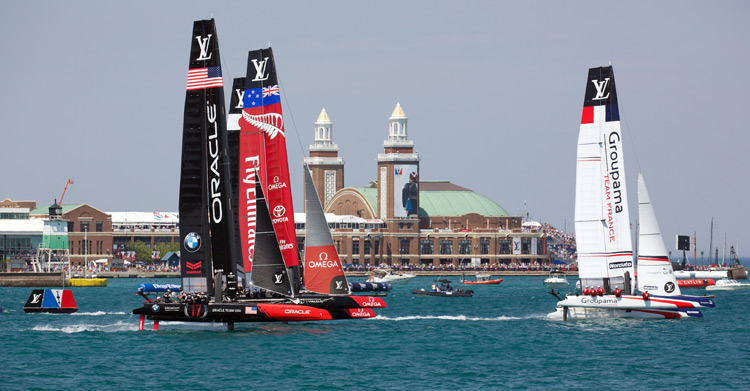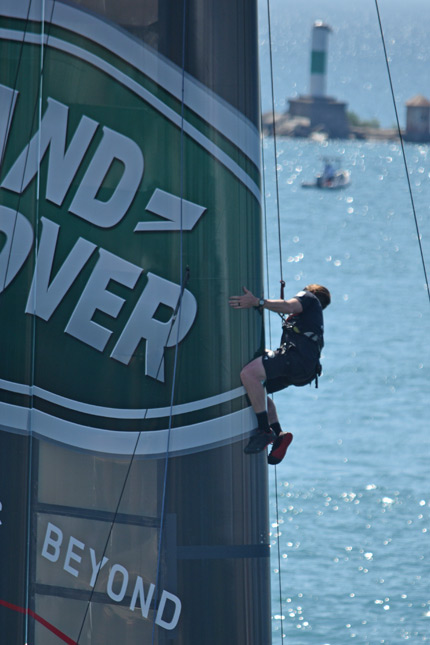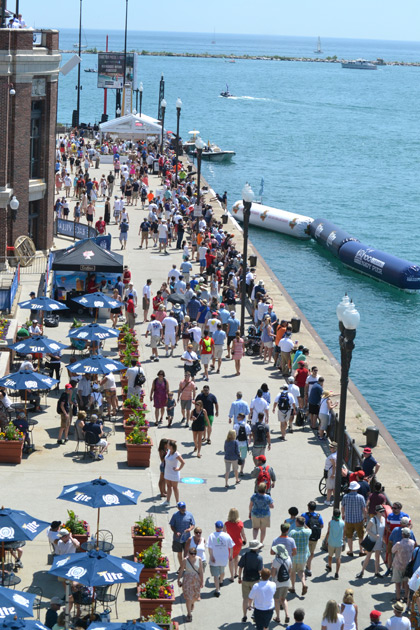Regatta Preview: Louis Vuitton America’s Cup
World Series Chicago
|
June 11, 2016 |

Photo: ©2016 R. Steven Tsuchiya
The foiling AC45F catamarans hit the Windy City this weekend, June 11-12, in the Louis Vuitton America’s Cup World Series Chicago. Six teams, five challengers and the defender, will race Saturday and Sunday on Lake Michigan, in the first freshwater competition for the America’s Cup boats.
Conditions are expected to be good for racing. The forecast for Saturday shows winds about 15 knots, with gusts to 21 kts of higher, nearly the same as Friday’s spectacular set-up that kept the boats at speeds close to 40 mph. Direction will be southwest to west, with flat water.
The Chicago race venue is in many ways the opposite of the tricky conditions seen in New York City last month, where strong currents and tides mixed with disturbed wind, frustrating the sailors and shuffling the race results.
The race area here is also located further from Chicago’s skyscrapers than in New York, tending to reduce the interference of the urban setting. Lake Michigan has no currents. Tides, though they exist, are imperceptible. Lake Michigan is also free from the floating seaweed seen at other venues that could foul on rudders and daggerboards.
The main wild card in the sailing conditions at this point, especially with predictions for above average temperatures, is the chance for thunderstorms . As of Saturday morning the chance of storms is more likely for late afternoon or into the evening. The early afternoon race schedule has a good chance of dodging intermittent storms if they occur.
 |
|
|
Climbing: Land Rover BAR inspects their wing before
Saturday's races. Photo:©2016 CupInfo.com |
Regardless of wind direction, organizers will try to set the course with the start/finish lines located as close to the end of the 3300-foot-long (1000-meter-long) Navy Pier as possible. The America’s Cup race village and VIP hospitality are located on the eastern end of the Pier, with grandstands, video screens, and other activities for 25,000 ticket-buying fans.
The Regatta Director has plenty of flexibility to see that the paid seats get the best view. The only overriding requirement for the ACWS race course is that the direction of the windward/leeward legs be aligned with the wind direction, so as to avoid favoring port or starboard tack over the other.
The start and finish lines, though, can be located at the upwind or downwind ends of the course, or in the middle of the course, on the port or starboard sides as needed. Generally, though, the officials will try to set the starting line at midcourse.
Each race can vary from three to eight legs, plus the finishing leg. Race officials adjust the number of legs, and the length of the course, in response to sailing conditions, aiming for an overall race time suited to television broadcast needs, ideally about 25 minutes long. Adjustments to the race course can be made from race to race, or even during a race, as needed.
Aside from the America’s Cup Village, the remainder of the Pier will still be free to the public, as was the entire event in New York.
There will also be free viewing opportunities along the shore, with the least obstructed views located to the south of the race area along Bond Drive, adjacent to the Adler Planetarium and the Shedd Aquarium, though the racing will take place at some distance. Navy Pier, or a spectator or excursion boat, will really be the best places to get close to the action.
Race days are Saturday June 11th and Sunday June 12th, up to three races each day, with the first start set for 1:37 pm local time (Central Time), 2:03 pm, and 2:33 pm. (Subject to weather conditions)
First place in a Saturday race awards 10 points, progressing down to 5 points for sixth place. Points are doubled for the races on Sunday. That means somewhere between 45 and 90 points to be awarded to each team if all 6 races are completed.
Winning the regatta would a nice honor, but what the teams are really chasing here is the points awarded for their finishing position in each race.
The cumulative race points at the end of all the 2015-2016 Louis Vuitton ACWS regattas will influence the seeding for the challenger selection process scheduled to begin in May 2017. One challenger team will be eliminated at the end of the Rounds Robin (termed the America’s Cup Qualifiers), and final standings after the ACWS can award the challengers bonuses carried into the Rounds Robin of the Qualifiers, which results in turn influence the pairings of the challenger Semi-Finals and Final (termed the America’s Cup Playoffs), and even the America’s Cup Match itself. So the points gained or lost to opponents in the ACWS could affect a challenger’s selection or elimination, so the teams take this preliminary racing seriously.
Chicago is the sixth of nine officially announced Louis Vuitton ACWS regattas. Only Portsmouth, England (July); Toulon, France (September); and (announced just last week) Fukuoka, Japan (November) remain on the schedule.
Emirates Team New Zealand has been holding on to their lead in the ACWS standings, currently at 244 points, with Land Rover BAR the next challenger at 227 points. They are followed by SoftBank Team Japan (203 pts.), Artemis Racing (201 pts.), and Groupama Team France (194 pts.).
Whether or not the fluky conditions in New York were the cause, in last month’s event several of the teams that have struggled previously were able to turn in race wins, including Groupama Team France with their second first-place finish of the 2015-2016 season. Team Japan also notched a first place in New York, though in a provisional “substitute” race that does not count in official results.
With more evenhanded sailing conditions, one key point to look for in Chicago is whether the AC45F fleet is evolving toward parity among the sailors, or whether the teams still stratified into upper and lower tiers.
The AC45F boats are supposed to be nearly identical to each other except for some tuning, setup, and maintenance factors. Louis Vuitton ACWS Chicago will offer a window into the progress the teams are making ahead of transitioning to their individual AC50 catamarans at the end of this year.
Though the teams are allowed to test their technology and develop crew work for the upcoming new yachts by sailing on “surrogate” boats, including modified AC45s, they don’t get full access to the ACWS AC45s except at the regattas and the couple days preceding racing. In Chicago, the boats didn’t even launch until the day before racing started.
Much of what they learn on the AC45F’s doesn’t transfer directly to the new boats, which will have one additional crewmember onboard, and entirely different control systems for foils and wings. And the ACWS regattas format is fleet racing, with all six boats competing against each other at once, while the actual America’s Cup and the challenger selection will be one-on-one match racing, which is an entirely different universe in sporting terms.
 |
|
|
Fans making their way to the end of Navy Pier on
Saturday morning. Photo:©2016 CupInfo.com |
What else to expect? Crowds. Though the America’s Cup Village is paid admission, limited to 25,000 visitors (and sold out), the immense Navy Pier facility draws tourist multitudes on any summer weekend. Built in 1916 as a combination commercial shipping facility and public recreation attraction, people have been flocking to the end of the Pier to enjoy lake breezes and Lake Michigan views for 100 years now. The pier was redeveloped solely as a tourist attraction in 1995, and is completing a much needed visual upgrade in its centennial year of 2016, with sleek modern design cues replacing the tourist kitchiness associated with last millennium’s festival marketplaces. An international event with global media coverage like the America’s Cup World Series could not have arrived at a better time, and the City and the Pier authorities have been very cooperative in accommodating the regatta. The team bases are located inside the 170,000 square-foot Navy Pier exhibition hall, but once launched the boats stay in the water unless repairs are needed.
Chicago was considered a finalist to host the 2017 America’s Cup, though both the Midwestern city and the other US finalist, San Diego, lost out to Bermuda. Still, the ACWS event in Chicago is widely regarded as an audition for more America’s Cup-related events on Lake Michigan in the future, possibly even one day defending the Cup here. Chicago is used to making huge public events work, and the Chicago Match Race group working as local host with the America’s Cup Event Authority has put together a venue for the weekend ACWS regatta that outshines San Francisco’s for the actual America’s Cup Match in 2013. A more serious attempt at the America’s Cup itself, whether as challenger or defender, could be in the future.
Expect to see plenty of people onshore and on the water. The response to the Louis Vuitton America’s Cup World Series not just in Chicago but across the Midwest appears to be very enthusiastic. Chicago alone has more than nine yachts clubs, and the country’s largest municipal harbor system, home to over 5,000 boats in nine different harbors.
Even on a normal summer weekend the lake often looks more white than blue with all of the boating activity. A weekend regatta with the worlds’ top sailors racing their foiling AC45F catamarans at 40-knots should make for a good spectacle as the America’s Cup moves toward the 2017 Defense.
--- ©2016 CupInfo.com